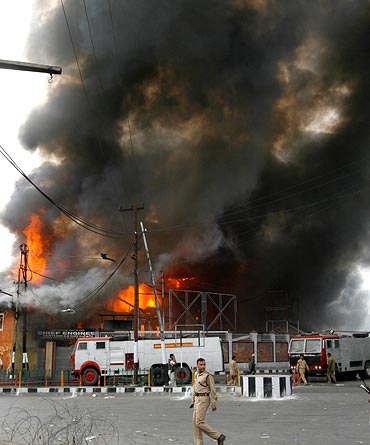 | « Back to article | Print this article |
What does 'Azaadi' mean for Kashmir?
In the debate on Kashmir, in the slogans being shouted by protestors in the Kashmir valley, the most common refrain is that of Azaadi.
Despite this, there is little clarity about what Azaadi actually means. Where does the motivation for Azaadi come from? Is Azaadi the proverbial opium that has been sold to successive generations by the previous ones, or, is it something more fundamental?
The demand for Azaadi has at least three triggers. One, by entering into a standstill agreement with Pakistan and a negotiating one with India, Maharaja Hari Singh had signalled his preference for independence. Pakistan overplayed its hand in trying to forcibly seize Kashmir by sending in 'raiders' on October 22, 1947.
Text: Salim Haq/ANI
Maharaja Hari Singh tried for Kashmir's independence
To save his state from the depredations of the tribal hordes, Maharaja Hari Singh acceded to India. Despite being a hated figure, there is grudging admiration for the attempt of the Maharaja to keep the state independent. That independence sentiment hasn't died till date.
Two, the wordings of the acceptance of the Instrument of Accession, followed up by the promise given by Pandit Jawaharlal Nehru at various fora, that India would ascertain the wishes of the Kashmiri people and honour the United Nation's resolutions calling for a plebiscite, provides the legal and international peg for Azaadi. That promise, in the Kashmiri perception, remains unfulfilled and is the starting point for alleged Indian duplicity, witnessed through the decades.
There are serious problems with 'Azaadi'
Perhaps, more than the strictly legal and international, the impulse for Azaadi stems from something more amorphous. This is the Kashmiri perception that they have a unique identity of their own that seeks political fulfillment through an independent state. With some, this impulse is secular -- expressed in the term Kashmiriyat. With others, it is increasingly becoming Islamic.
However, there are serious problems with Azaadi, both ideological and practical. For one thing, what does Azaadi actually mean and to whom?
There is no third option of independence
If Azaadi means freedom or independence, then clearly the Kashmiris are barking up the wrong tree by demanding implementation of UN resolutions. The UN resolutions do not provide for the right of self-determination, but only the right of accession to either India or Pakistan.
There is no third option of independence in the UN Resolutions. A not so publicised fact is that it was Pakistan that had opposed the third option of independence when the UN resolutions were being framed. It has been a major failing of the government of India that it has not gone to town with this fact.
Is it then Azaadi FROM either India or Pakistan?
Is Azaadi then limited to accession to either India or Pakistan?
Is it then Azaadi FROM either India or Pakistan?
Or, is Azaadi freedom from the ubiquitous presence of security forces, freedom from the daily checking and harassment, freedom from the fear of not returning from work/school, freedom of speech and assembly, freedom from the gun culture, freedom from corruption, or, freedom to go to school unhindered?
Many Muslims oppose 'Azaadi'
Is it then Azaadi TO be normal citizens of a secular democracy?
On the practical side, the Azaadi discourse is dominated by the valley and that too by a section of the Muslims living there. There are many Muslims in the valley opposed to either Azaadi or the growing Islamic radicalisation. They are, as yet, silent spectators watching which way the wind will turn. They are wary of government flip-flops that afford them no protection should they articulate a contrary viewpoint.
For Geelani, the colour of Azaadi is green
The separatists led by Syed Ali Shah Geelani and Massarat Alam are very clear that the conflict in Kashmir is one between Islam on the one hand and Kufr on the other. Geelani has been quoted as saying that for a Muslim to live in a non-Muslim dominated area is as difficult as it is for a fish out of water. According to him, Islam demanded that the Kashmiri Muslims continue to struggle for separation from non-Muslim dominated India and set up an Islamic state.
For Geelani, and his ilk, Islam would dominate in the Kashmir of their vision. While they do pay lip service to Kashmiriyat, the colour for their concept of Azaadi is clearly green.
But if Kashmiriyat is subsumed by Islam, where does it leave the minorities?





